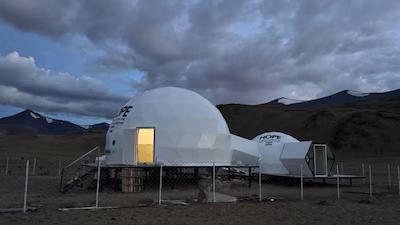
ISRO Sets Up Station in Ladakh to Simulate Life on Moon and Mars
In a significant step towards the ambitious mission to explore the lunar and Martian surfaces, the Indian Space Research Organisation (ISRO) has set up a unique simulation station in Ladakh’s Tso Kar Valley. Dubbed the Himalayan Outpost for Planetary Exploration (HOPE), the facility is designed to test the life-support systems for future lunar and Martian missions. Two crew members will undertake various tests at the facility from August 1-10, marking a significant milestone in India’s space exploration journey.
The Tso Kar Valley was chosen for this simulation mission due to its unique terrain, which bears a striking resemblance to the Martian environment. The valley is characterized by high UV radiation, low atmospheric pressure, extreme cold, and saline permafrost – all of which are similar to the conditions found on Mars. This makes it an ideal location for testing the equipment and survival strategies that will be required for future Martian missions.
The HOPE station is equipped with a range of facilities, including a habitat module, a life-support system, and a solar panel array. The habitat module is designed to mimic the living quarters of astronauts on a lunar or Martian mission, complete with a controlled environment that can simulate the conditions on the Moon or Mars. The life-support system, on the other hand, is designed to provide a sustainable source of air, water, and food for the crew.
The crew members who will be stationed at HOPE for the next 10 days will be undertaking a range of tests and experiments to assess the performance of the equipment and the crew’s ability to thrive in the challenging environment. They will be conducting experiments on the effects of high UV radiation on materials and equipment, testing the life-support system, and evaluating the performance of the solar panel array.
The HOPE station is not just a simulation facility; it is also a testing ground for new technologies and innovations that will be required for future space missions. ISRO scientists and engineers will be using the facility to test and refine new technologies, such as advanced life-support systems, robotic arms, and communication equipment.
The significance of the HOPE station cannot be overstated. It is a major step towards India’s ambition to send humans to the Moon and Mars in the coming years. The experience and knowledge gained from this simulation mission will be invaluable in planning and executing future missions, and will help India to establish itself as a major player in the global space exploration community.
The HOPE station is also a testament to India’s commitment to space exploration and its determination to push the boundaries of what is possible. The country has made significant progress in recent years, with the successful launch of the Chandrayaan-1 mission to the Moon and the Mangalyaan mission to Mars. The HOPE station is the latest example of ISRO’s innovative approach to space exploration, and its willingness to take risks and push the boundaries of what is possible.
In conclusion, the HOPE station in Ladakh’s Tso Kar Valley is a significant milestone in India’s space exploration journey. The simulation mission will provide valuable insights and experience for future lunar and Martian missions, and will help India to establish itself as a major player in the global space exploration community. As ISRO continues to push the boundaries of what is possible, the world will be watching with interest to see what the future holds for India’s space program.
Source:






